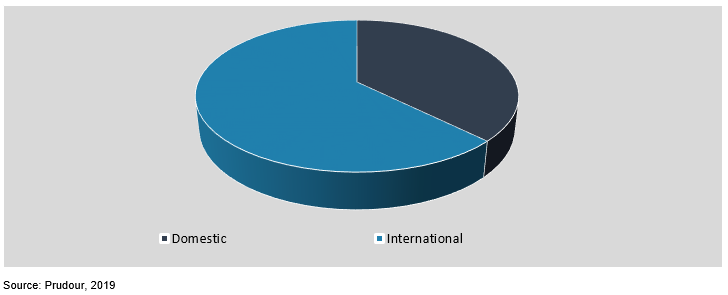Іnсrеаѕіng Prеfеrеnсе Tоwаrdѕ аіr trаvеl аnd Chаngіng thе Lіfеѕtуlе оf Cоnѕumеrѕ Boost Lоw Соѕt Аіrlіnеѕ Маrket
At Market.us News, we strive to bring you the most accurate and up-to-date information by utilizing a variety of resources, including paid and free sources, primary research, and phone interviews. Our data is available to the public free of charge, and we encourage you to use it to inform your personal or business decisions. If you choose to republish our data on your own website, we simply ask that you provide a proper citation or link back to the respective page on Market.us News. We appreciate your support and look forward to continuing to provide valuable insights for our audience.
Passenger airlines that offer service tickets at a comparatively cheaper cost than traditional or full-service airlines are known are low-cost airlines. They are also known as prizefighters, frills airlines, budget airlines, low-cost carriers(LCCs) and discount airlines. Southwest Airlines introduced the concept of low-cost or budget airlines in the 1970s with the sole objective of offering discounted airfares to its consumers. They achieve this by undercutting the price levels of flagship carriers.
Market.us has recently published a market research report titled, “Global Low-Cost Airlines Market by Type, and by Application – Forecast from 2019 to 2028”. This report offers an all-encompassing analysis of the low-cost airline market. It is through research efforts, both primary and secondary, that the research results have been comprehensively examined over the study period. The low-cost airline market is projected to have a valuation of over US$ 458 billion, from its estimated revenue of US$ 19 billion generated in 2018.
The low-cost model is a customized version of the Southwest Airlines model of operation. The strategy remains the same. Create a sustainable cost advantage over its competitors. Presently, there are many airline companies that implement this model of operation. Since there is stiff competition, each of these airlines modifies their strategies to stand out from the pack. This modification of strategies is known as a differentiation strategy. These companies pitch differentiated products that might offer value to the customer. In doing so, they increase the market share of that particular company. In seasoned markets such as that of the US, differentiation strategies are extremely evident. This is achieved when operators strike a balance between the service model and the low-cost model in order to formulate maximum profit margins.

The contrivance behind a low-cost airline is to cut the most amount of cost by providing a customer with a product that has a low price and includes the bare essentials. In recent times, these airlines have adopted and implemented varying methods to go about achieving this. From price strategy, simple pricing structure, point-to-point networks, single seating arrangements, dense seating arrangements, exhaustive aircraft usage, etc.
A surge in the income of the middle-class and a considerable increase in an individual’s disposable income, especially in countries that are presently developing are crucial factors that are responsible for the growth of the global low-cost airline market. Other factors that contribute to the surge of the low-cost airline market are urbanization, a change in the lifestyle of consumers, a preference for air travel, and the convenience of air travel when compared to other forms of travel. A challenge that is faced by most low-cost airline vendors is higher investments with a low profitability scale. A majority of companies reduce the fares of their service to increase the customer base they are targeting. In doing so, they incur low-profit margins. And, this makes it difficult to sustain themselves in this market in the long run.
The low-cost airline market can be segmented on the basis of product type, application, and region. On the basis of type, the international segment appears to be the most financially rewarding in the global low-cost airline market. In terms of region, the market is segmented into North America, Europe, Japan, China, Southeast Asia, India, South America, and the MEA followed by the rest of the world.
The global low-cost airline report includes company profiles of major players such as AirAsia Group Berhad, Alaska Air Group, Inc., WestJet Airlines Ltd., Qantas Airways, International Consolidated Airlines Group, S.A., Go Airlines (India) Ltd., Norwegian Air Shuttle ASA, easyJet plc, Ryanair Holdings plc, GOL Linhas Aéreas Inteligentes S.A., SpiceJet Limited, Dubai Aviation Corporation, Air Arabia PJSC, JetBlue Airways Corporation, Southwest Airlines Co., etc.

Anurag Sharma
He has been helping in business of varied scales, with key strategic decisions. He is a specialist in healthcare, medical devices, and life-science, and has accurately predicted the trends in the market. Anurag is a fervent traveller, and is passionate in exploring untouched places and locations. In his free time, he loves to introspect and plan ahead.
Latest from Author
- “After years of tension, Israel and Lebanon agree to historic deal”
- Ales Bialiatski, Russia’s Memorial and Ukraine’s Center for Civil Liberties win Nobel Peace Prize 2022
- We have listened : UK drops income tax cut for highest earners
- Rupee drops to 81.89 dollars
- ‘Cannibal’ Eruptions From the Sun May Possibly Disrupt GPS Systems This Week